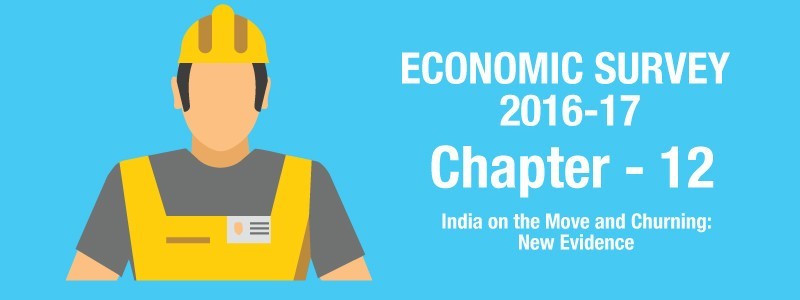Chapter 12 – India on the Move and Churning – Highlights of Economic Survey 2016-17
Chapter 12 of the Economic Survey 2016-17 talks about labour migration and the prevailing economic conditions in the country. The Economic Survey conducts an extensive study to arrive upon various conclusions. This chapter is not that important for UPSC Prelims, but topics such as migration, urbanization, female labour force etc can be a part of your Mains examination.
The traditional view, based on a straightforward reading of the 2001 Census, is that the stock of migrants in India is low (around 33 million), and not increasing very rapidly.
Existing environment related to migration:
- There exist discouraging incentives such as domicile provisions for working in different states,
- Lack of portability of benefits, legal and other entitlements upon relocation.
Three findings related to Indian migration and movement of people:
- India is increasingly on the move – and so are Indians. Annually inter-state labour mobility averaged 5-6 million people between 2001 and 2011, yielding an inter-state migrant population of about 60 million and an inter-district migration as high as 80 million.
- Migration is accelerating. In the period 2001-11, according to Census estimates, the annual rate of growth of labour migrants nearly doubled relative to the previous decade, rising to 4.5 per cent per annum in 2001-11 from 2.4 per cent in 1991- 2001.
- While internal political borders impede the flow of people, language does not seem to be a demonstrable barrier to the flow of people.
The growth rate of migrants rose spectacularly to 4.5 per cent per annum, while the workforce growth rate actually fell. Thus, the migrants’ share of the workforce rose substantially. A breakdown by gender reveals that the acceleration of migration was particularly pronounced for females.
The Economic Survey 2016-17 also mentions the term “Circular migration” (It states that labour migration in India tends to be circular in nature in both short and long-term migration streams and is not adequately captured by Census data).
*Circular migration or repeat migration is the temporary and usually repetitive movement of a migrant worker between home and host areas, typically for the purpose of employment.
Facts about migration in India:
- Internal migration rates have dipped in Maharashtra and surged in Tamil Nadu and Kerala reflecting the growing pull of southern states in India’s migration dynamics.
- Out-migration rates increased in Madhya Pradesh, Bihar and Uttar Pradesh and have dipped in Assam.
- The sum of all the out-of-state net migrants in the 20-29 age cohort for the period 2001-11
- Until the 2000s, migration was largely a male dominated phenomenon. But in the 2000s there was a marked shift in the distribution for females.
The Economic Survey 2016-17 also uses net annual flows of unreserved passenger travel as a proxy for work-related migrant flow.
- There is an interesting dynamic between Gujarat and Maharashtra where Surat has started acting as a counter magnet region to Mumbai and attracts migrants from the neighboring districts of Maharashtra. Other counter- magnet region dynamics are observed in Jaipur and Chandigarh (to Delhi).
The Economic Survey 2016-17 utilizes several gravity models and CMM econometric studies to arrive upon findings regarding Migration. As an UPSC aspirant, you need not worry about these models since it wouldn’t be a part of your Civil Services examination.
- The patterns of migration – less affluent states and districts evince higher out-migration, and rich metropolises attract large inward flows of labour.
The Economic Survey also predicts an increasing rate of growth of migrants over the years.
Initiatives to sustain the migration momentum:
- Portability of food security benefits, healthcare,
- A basic social security framework for the migrant is crucial – potentially through an interstate self-registration process.
- Enhancing financial inclusion for migrant workers and family.
Also Read : Top 10 Key Highlights of Economic Survey 2016-17 for UPSC Aspirants
Also Read: Chapter wise highlights of Economic Survey 2016-17
Chapter 01 – Economic Outlook and Policy Challenges
Chapter 02 – The Economic Vision for Precocious, Cleavaged India
Chapter 03 – Demonetization: To Deify or Demonize?
Chapter 04 – The Festering Twin Balance Sheet Problem
Chapter-05 – Fiscal Framework: The World is Changing, Should India Change Too?
Chapter 06 – Fiscal Rules: Lessons from the States
Chapter 07 – Clothes and Shoes: Can India Reclaim Low Skill Manufacturing?
Chapter 08 – Review of Economic Developments
Chapter 09 – Universal Basic Income
Chapter 10 – Income, Health, and Fertility: Convergence Puzzles
Chapter 11 – One Economic India
Chapter 12 – India on the Move and Churning
Chapter 13 – The ‘Other Indias’ – Highlights of Economic Survey 2016-17
Chapter 14 – From Competitive Federalism to Competitive Sub-Federalism
Download PDF to your email
*/ ?>The Only Resource Needed To Crack The UPSC Prelims Test 2017
Monthly Current Affairs Archives

 Login
Login

![Salient features of Right to Information [RTI Act ] 2005](https://www.selflearn.co.in/wp-content/uploads/2017/07/SALIENT-FEATURES-OF-RIGHT-TO-INFORMATION-RTI-ACT-2005-FOR-CIVIL-SERVICES-IAS-EXAM-PREPARATION-1-81x66.jpg)
![Right to Information [ RTI Act ] 2005 -Historical Background](https://www.selflearn.co.in/wp-content/uploads/2017/07/RIGHT-TO-INFORMATION-RTI-ACT-2005-FOR-CIVIL-SERVICES-IAS-EXAM-PREPARATION-01-81x66.jpg)













